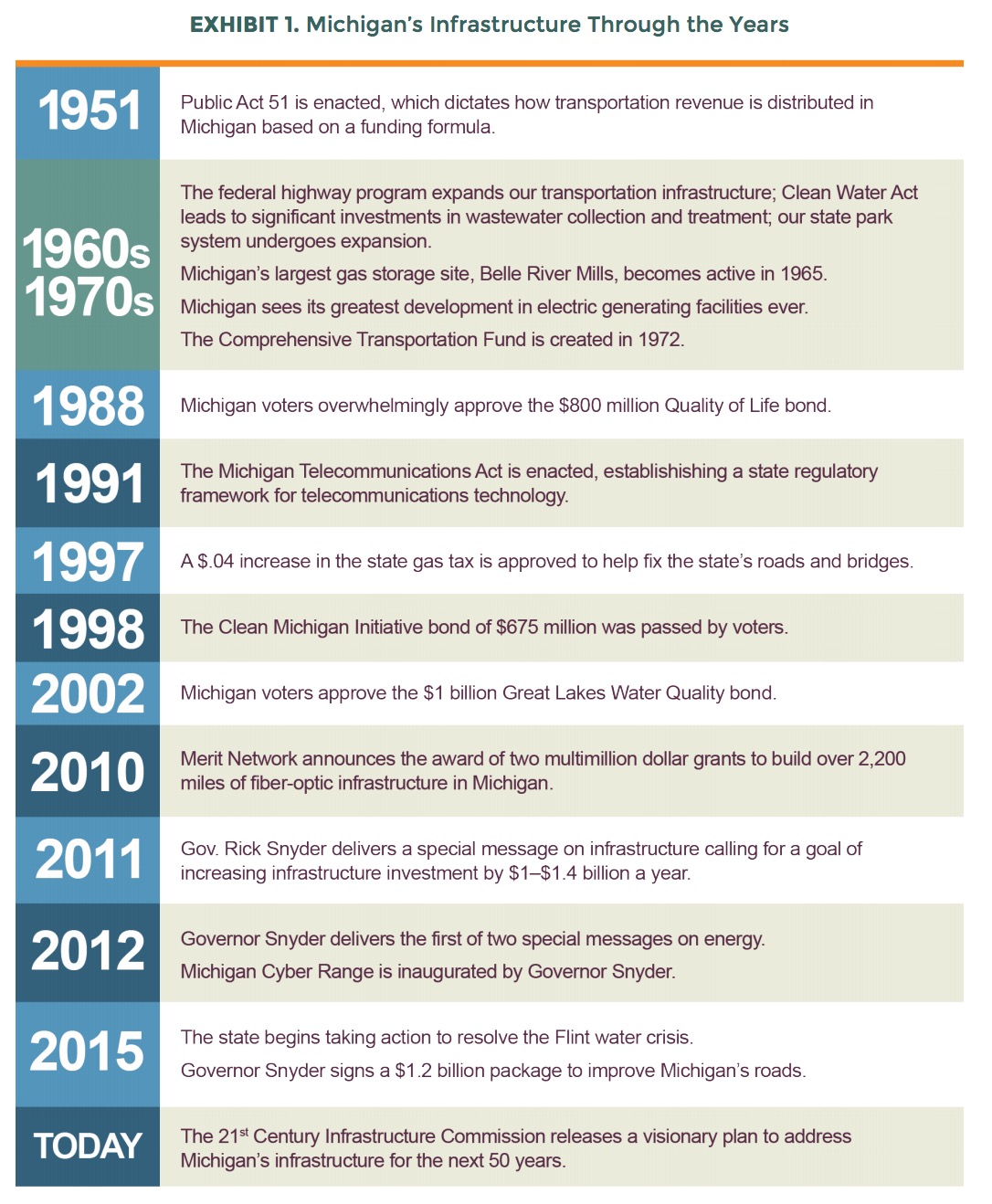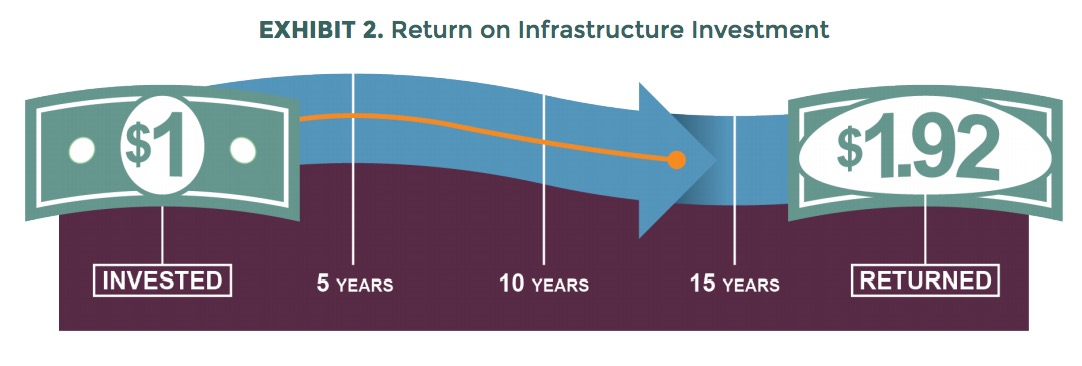21ST CENTURY INFRASTRUCTURE COMMISSION
Chapter 1: Introduction
Background
Infrastructure is the foundation of Michigan’s modern economy and quality of life. When most people hear the term “infrastructure,” they often think of roads or bridges; however, these assets are just pieces of a larger, more complex picture that includes water and sewer systems, drains and stormwater systems, broadband and communication systems, and electricity and natural gas networks.
Michigan’s infrastructure is aging, and maintenance has been deferred for decades, leaving us in a state of disrepair. Failing infrastructure interrupts daily life, slows commerce, jeopardizes public health, pollutes the environment, and damages quality of life. This is evidenced by the condition of our current system:
- 39 percent of roads are in poor condition (TAMC 2015)
- 27 percent of bridges are structurally deficient or functionally obsolete (MiBRIDGE 2016)
- Water contamination in the city of Flint threatens the health and safety of its residents
- Since 2008, an average of 5.7 billion gallons of untreated sewage flowed into Michigan waterways (MDEQ October 2016 a.)
- 64 rivers that drain 84 percent of Michigan’s Lower Peninsula tested positive for human sewage (Verhougstraete et al. 2014)
- Nearly 25 percent of beaches experienced closures in 2015 (MDEQ May 2016)
- Approximately 130,000 (10 percent) of the state’s 1.3 million septic systems are likely experiencing operational problems (Creagh 2016)
- Property damage from flooding is increasing (Saunders 2014)
- Approximately 12 percent of the state’s households lack access to advanced broadband service (Connect Michigan 2015)
- Planned power plant retirements in the Upper Peninsula have posed challenges to balancing reliability and affordability
Without intervention—including adequate planning, management, and investment—Michigan will continue to experience infrastructure failures, leading to impacts on our public health, environment, and overall quality of life.
The 21st Century Infrastructure Commission (referred to as “the Commission”) recognizes the need to ensure the health, safety and welfare of Michigan’s residents. Infrastructure planning, management, and investment that holistically acknowledges transportation, water, stormwater, energy, and communications needs is the best way to ensure protection of public health, the environment, and the state’s future economic growth.
A 21st century infrastructure system in Michigan must have resilient, adaptive, and robust infrastructure systems in both rural and urban communities. Outcome-based decision-making tools and appropriate incentives will drive the development of sound 21st century infrastructure systems. Michigan must establish regulatory and tax policies that encourage infrastructure innovation and investment, and build public confidence. In order to achieve efficiencies and support adequate investment, public and private partners at all levels must coordinate asset management and planning across infrastructure types and work together to leverage diverse, integrated, and sustainable funding.
…
National Infrastructure Spending
Michigan is not alone in its infrastructure challenges. Infrastructure needs abound in communities and states across the country and around the world. In 2013, the American Society of Civil Engineers (ASCE) gave America’s infrastructure overall a grade of “D-plus,” and reports that the nation would need to spend an additional $3.6 trillion by 2020 to raise national infrastructure to a state of good repair. Given the recent Flint water crisis and growing concern about the condition of underground infrastructure across the state, Michigan’s portion of the investment needs has likely grown significantly.
During the past decade, states across the U.S. have been cutting public infrastructure spending, causing infrastructure investment to drop from a high of 3 percent of the nation’s gross domestic product (GDP) in the late 1960s to less than 2 percent in 2014 (McNichol 2016). States have not been alone in cutting spending on infrastructure; since 2003, federal spending on infrastructure has fallen by almost 19 percent, while spending by states and municipalities has dropped by approximately 5 percent (McNichol 2016).
This decline in investment has emerged despite strong evidence that spending on physical infrastructure has a positive return on investment. The return on infrastructure investment is nearly twice initial spending because it is frequently less expensive to maintain existing infrastructure than it is to repair or replace it, and newly created infrastructure is far less likely to need repairs or replacements. On average, every $1.00 spent on nonresidential construction has an economic impact of $1.92. For transportation and power investment, $1 returns $4.24, while $1 of spending on water and sewer assets returns $2.03 in revenue (Cohen 2012).
Not only are there sizable economic arguments for infrastructure investment, there is also a case to be made for making infrastructure improvements sooner rather than later. As shown in the example in Exhibit 3, deferring infrastructure investment will actually make a project more expensive, as the costs of infrastructure repair and or replacement increases as infrastructure quality declines.
View full version (miinfrastructurecommission.com): 21st Century Infrastructure Commission Report
About the 21st Century Infrastructure Commission
miinfrastructurecommission.com
Executive Order 2016-5 created the 21st Century Infrastructure Commission, which was announced in Governor Snyder’s State of the State address in January. The Commission, comprised of state and independent industry experts, is charged with identifying strategic best practices to modernize the state’s transportation, water and sewer, energy, and communications infrastructure over the next 30-50 years.
Tags: 21st Century Infrastructure Commission, Michigan, Michigan Infrastructure Commission, Rick Snyder MI








 RSS Feed
RSS Feed